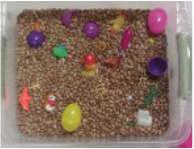

1 Box
1 Large Bag of uncooked beans
Random small toys (lizards, frogs, toys from kids meals, plastic eggs, puzzle pieces, or anything that you are missing a counterpart for)
Scoopers (spoons, bucket, bowl, and cup)
Sheet/blanket
I had most of these materials laying around my home/office and I only needed to purchase a large bag of beans which cost me about $10. First, lay the sheet/blanket down for easy clean-up later. Next, simply open the bag of beans and dump them into the box. Then let your kiddo “hide, dig, fill, and find” the items inside the beans. It is so simple and the kiddos just LOVE this activity.
How can such a simple activity address the developmental areas?
Receptive Language (understanding what others are saying)- Use simple language to explain what you are doing and/or label items and actions. Words such as, “bean, ball, ssssss (for snake), in/out, more, all done, scoop, pour” are all simple vocabulary words that your child could learn from this activity. Remember to keep your language simple and age-appropriate for your child.
Expressive Language (using language to express him/herself)- Encourage imitation of sounds, words, or signs modeled by you. This is a wonderful way to “trick” your child into using all of those words they have been storing up for the perfect occasion.
Pragmatic Language (social skills)- This activity could be played with adults and peers. It is an excellent opportunity to practice reciprocal play (e.g., one person holds a bowl which another person fills it with beans), turn-taking (e.g., “you scoop, I scoop”) , and asking/answering questions.
Speech (sound production/pronunciation)- Exploring age-appropriate consonants is always a great idea during play activities. For example, if you have some animals in your Bean Box you could practice the animal sounds as they are discovered (working on sound productions at the beginning of a word). Such as, “moooo” for cow, “sssss” for snake, “baaa” for sheep, etc.
Fine Motor – Have your child practice grabbing hidden objects with his/her thumb and index finger and place it in a cup/egg/bowl, clap his/her hands every time they find a certain toy, stir the beans with a spoon, or pretend to “feed” a doll/animal.
Gross Motor– Practice sitting with legs crossed or have them lay on their tummy while playing to strengthen the core muscles.
Sensory Integration– Have your child explore the different sensations of the beans and toys on their fingers or have your child push the box to/from the activity area for some “heavy work.”
If you have questions about addressing developmental skills with toys you already own, talk to your speech-language pathologist and/or occupational therapist today.
Happy Playing,
Amy Grant, M.S., CCC-SLP



 RSS Feed
RSS Feed
